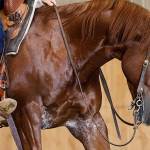Pain in the Neck: CT Imaging Reveals Cervical Problems in Horses

Because neck pain or discomfort can derail athletic performance, veterinarians act quickly to diagnose and resolve the underlying problem. Signs of neck pain include reduced range of motion, altered head carriage, and muscle atrophy. When the nervous system is implicated, stumbling or forelimb lameness may advance to severe ataxia, even paralysis.
Improved diagnostic imaging, notably computed tomography (CT), facilitates diagnosis of cervical spinal problems, and modern CT scanners can accommodate the entire span of the cervical chain, even in large, mature horses. Pathological conditions of these joints include osteoarthritis, osteochondritis dissecans (OCD) or similar lesions, and fractures. Also found are detached pieces of tissue within cervical joints, often described as osteochondral fragmentation. Researchers theorize these fragments might materialize from trauma or one of the aforementioned conditions, though etiology has not been established absolutely.
Researchers at Liphook Equine Hospital, Liphook, Hampshire, U.K., set out to determine the prevalence of osteochondral fragmentation within the cervical joints of horses with evidence of orthopedic or neurological deficits.*
The retrospective study included 55 horses of various ages, breeds, and uses. Osteochondral fragmentation was observed in 13, or 24% of horses, and was identified at every joint within the neck (e.g., between C1-C2, C2-C3, etc.). Most fragments were observed in C4-C5 and C7-T1, where T-1 signifies the first thoracic vertebra. Of these 13 horses, additional pathology was noted in 11. Because of the multilayered pathology found in these 11 horses, it was difficult for researchers to definitively attach clinical significance to osteochondral fragmentation.
According to the researchers, “further investigation is required to confirm their clinical significance and develop potential treatment options where necessary.”
In a separate study, veterinarians reported on the arthroscopic removal of cervical osteochondral fragments in three Warmblood horses.** All of the horses presented with reduced range of motion of the neck, two with forelimb lameness, and one with neurologic signs, notably stumbling. In these horses, fragments were located between C5-C6 and C6-C7. All three horses were sound for their intended use 14 to 31 months after surgery with no neurological deficits, though one horse had a second surgery to remove more fragments.
While there is nothing to suggest that osteochondral fragmentation stems from inadequate nutrition, scientists know that development of OCD may be influenced by nutrition. “Young, growing horses should be offered a nutritionally sound diet from the time they require more nutrition than that afforded by their dams’ milk. OCD is often considered a multifactorial disease, meaning several influences—genetic predisposition, nutrition, exercise, and environment—may conspire to cause clinical relevance,” explained Catherine Whitehouse, M.S., a nutritionist with Kentucky Equine Research.
If a question arises about the nutritional well-being of a young horse, especially one that seems to be growing too slowly or too quickly, a qualified nutritionist should be consulted immediately.
“A change in feed or feeding management will usually set the young horse right again, assuming any problem has been caught quickly. Breeders must always be cognizant of how fragile the skeletons of young horses really are, especially at key points in their development,” Whitehouse said.
*Tucker, R., Y.S. Hall, T.K. Hughes, and R.A. Parker. 2022. Osteochondral fragmentation of the cervical articular process joints; prevalence in horses undergoing CT for investigation of cervical dysfunction. Equine Veterinary Journal 54:106-113.
**Schulze, N., A. Ehrle, I. Beckmann, and C. Lischer. 2021. Arthroscopic removal of osteochondral fragments of the cervical articular process joints in three horses. Veterinary Surgery. doi: 10.1111/vsu.13681.








